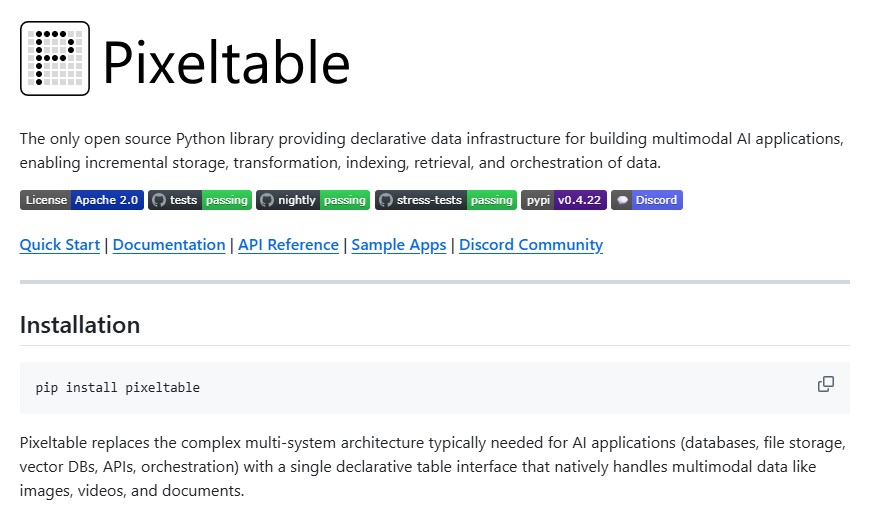In the rapidly evolving AI landscape, building intelligent applications is no longer just about having powerful models. The real challenge lies in handling complex data pipelines, integrating multiple systems and scaling multimodal workloads efficiently. Traditional AI app development stacks involve databases, vector stores, ETL pipelines, model serving layers, orchestration tools, caching systems and lineage tracking solutions. Maintaining all these components drains time, increases cost and slows innovation.

Pixeltable, an open-source Python library, is redefining how modern AI applications are built. It introduces a declarative, incremental and unified data infrastructure designed specifically for multimodal AI workflows. Instead of juggling different tools for structured data, images, videos, embeddings and LLM outputs, Pixeltable brings everything into a single table-centric interface.
This article explores Pixeltable’s core features, benefits and how it empowers developers to build scalable production-grade AI applications with dramatically simplified architecture.
What Is Pixeltable?
Pixeltable is the only open-source data infrastructure library that allows developers to manage multimodal data, run transformations, execute AI inferences, store outputs and build end-to-end AI pipelines – all within a single declarative table interface.
It supports:
- Images, videos, audio, and documents
- Computed columns for automatic data processing
- Integration with OpenAI, Hugging Face, YOLOX, Anthropic, and more
- Vector indexing and similarity search
- Incremental computation and lineage tracking
- Time-travel queries and versioning
- UDFs and Python-native workflows
- Export to ML frameworks like COCO, PyTorch, and Label Studio
Developers can insert multimodal data, trigger AI inference, compute embeddings, store results and query outputs without touching external file systems or vector stores.
Why Pixeltable Matters for AI Development ?
1. One Platform, Multiple AI Capabilities
Most AI projects require multiple systems: PostgreSQL for structured data, S3 for media storage, Pinecone or LanceDB for vectors, an orchestration tool for tasks and APIs for model inference. Pixeltable eliminates this fragmentation with a single unified system.
2. Declarative Data Processing
Pixeltable uses computed columns meaning once logic is defined, it automatically applies to data and only recomputes when needed. This removes manual pipeline maintenance and makes workflows predictable and reproducible.
3. Native Multimodal Support
Images, videos, audio, PDFs and text are handled as first-class data types. Developers can store, transform and search multimodal inputs without third-party tools.
4. Embedded AI Tools
Pixeltable integrates directly with popular AI frameworks:
- OpenAI chat and vision models
- Hugging Face Transformers and CLIP
- YOLOX object detection
- Sentence-Transformers for embeddings
This drastically simplifies building LLM-powered apps, vision systems and RAG pipelines.
5. Incremental and Versioned Workflows
Pixeltable automatically tracks data lineage, computed results and schema changes. Developers can time-travel, revert tables and re-run only changed computations saving time and compute costs.
Key Features Explained
Unified Storage and Processing
Pixeltable stores structured output in Postgres and media files locally managing them seamlessly through a single interface.
Computed Columns
Define once, run everywhere:
t.add_computed_column( detections=huggingface.detr_for_object_detection(t.input_image) )
Vector Indexing and Semantic Search
Perform text-to-image and image-to-image search without standing up a vector DB:
images.add_embedding_index('img', embedding=clip.using(...))
RAG-Ready Workflows
Chunk documents, embed text, retrieve context, and query LLMs in one pipeline.
Bring Your Own Code
Write UDFs for custom logic:
@pxt.udf def format_prompt(context, question): ...
Practical Use Cases
Pixeltable is ideal for:
- AI-powered media search engines
- Vision-based analytics platforms
- Agentic AI applications
- Multimodal RAG systems
- Dataset preparation for ML training
- Content moderation and classification systems
- Automated video/audio transcription pipelines
For startups and enterprises looking to build AI products, Pixeltable shortens development cycles and reduces infrastructure overhead.
Future Roadmap
Pixeltable plans to launch a hosted cloud platform enabling:
- Cloud-hosted multimodal data sharing
- Production deployment environments
- API and MCP endpoints for tables, UDFs, and query jobs
This will transform Pixeltable from a powerful toolkit into a fully managed AI data infrastructure layer.
Conclusion
Pixeltable represents a major step forward in simplifying multimodal AI development. By combining storage, computation, embeddings, versioning and model integration into a single declarative interface, it empowers developers to move faster, prototype smarter and scale efficiently. Whether you are building vision-powered apps, multimodal RAG systems or agent-based tools, Pixeltable offers a unified pipeline that cuts complexity and accelerates innovation.
As multimodal AI becomes the new default, infrastructure must evolve and Pixeltable is leading that transformation.
Follow us for cutting-edge updates in AI & explore the world of LLMs, deep learning, NLP and AI agents with us.
Related Reads
- Meilisearch: The Lightning-Fast, AI-Ready Search Engine for Modern Applications
- Kimi Linear: The Future of Efficient Attention in Large Language Models
- FIBO: The First JSON-Native, Open-Source Text-to-Image Model Built for Real-World Control and Accuracy
- olmOCR: Redefining Document Understanding with Vision-Language Models
- DeepSeek-V3: Pioneering Large-Scale AI Efficiency and Open Innovation

2 thoughts on “Pixeltable: The Future of Declarative Data Infrastructure for Multimodal AI Workloads”